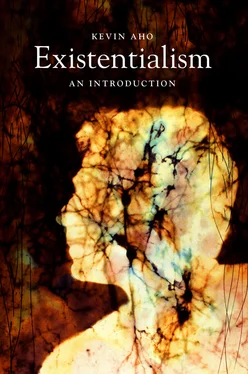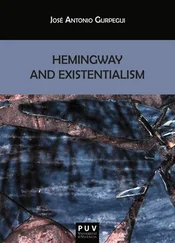One of the more significant contributions of the existentialist account of being-in-the-world is that it makes it possible to engage perspectives that have been historically marginalized in the Western tradition. If, as the existentialist argue, we can make sense of things only from within a situated and embodied orientation, then this orientation must also be shaped by aspects of alterity or ‘otherness’ such as madness, racial and sexual difference, and physical disability. These aspects not only inform our embodied ways of being but they can also disrupt the seamless weave between self and world. Psychiatrist and philosopher Frantz Fanon (1925–1961), for instance, drew on his own experiences of racism as a black man born and raised in the French colony of Martinique to expand on and critique Merleau-Ponty's conception of being-in-the-world. He argued that the ‘bodily schema,’ the pre-conscious sensory-motor grip on the world that we normally take for granted, is not present in the same way for colonized people (see Weate 2001). Fanon introduces what he calls the “historical-racial schema” that captures the black experience of confusion and alienation, a result of being forcibly “ woven out ” (1967, 111) of the shared meanings and practices that constitute the white European world. Because he does not belong to the European world, the colonized black man does not share the same pre-objective understanding that the European has. For Fanon, then, Merleau-Ponty's account of the bodily schema does not map onto the particularities of “the being of the black man” (110).
Fanon goes on to suggest that there is a deeper layer of alienation that he calls the “racial epidermal schema” (112). Drawing on Sartre's conception of ‘the look’ ( le regard ), Fanon describes how the black man's connection with the world can be disrupted when he is transformed into a brute object or thing by the judgmental gaze of the white European. In these situations, the black man feels immobilized and incapacitated, finding it difficult to stretch into the world, to handle equipment, and participate in public activities. The smooth, pre-conscious synergy that characterizes the European's existence is out of reach. He becomes imprisoned in a sphere of immanence, where his physical motility and sense of self are constrained by his skin color. He feels completely “dislocated [and] unable to be abroad with the other” (112). The result is a very different way of moving through the world and inhabiting lived space. The black man is inhibited; he embodies shame in the way he walks and carries his shoulders, in his lowered head and reluctance to make eye contact, and in his deferential way of speaking. Fanon refers to a feeling of “nausea” (116) to convey the sense of being trapped in the racial-epidermal schema that emerges from internalizing the objectifying and dehumanizing judgments of the European. He offers a personal example of how the racial-epidermal schema emerges in the simple statement of a white child pointing at him on a train and saying to his mother, “Look a Negro” (114). For Fanon, this statement already contains a host of sociocultural assumptions that transform him into an object, into a hostile, even bestial, thing. Fanon is suggesting that the bodily schema of those who are colonized is penetrated by a sense of alienation and objectification that culminates in the paralyzing experience of being “walled in” (117) by the color of their own skin.
The feminist philosopher Iris Marion Young (1949–2006), drawing on the work of Beauvoir and Merleau-Ponty, makes an analogous point regarding a woman's motility and sense of spatial orientation. Young argues that “there is a particular style of bodily comportment that is typical of feminine existence” that is often overlooked (2005, 31). These differences in comportment are not the result of any essential differences between man and woman in terms of biology or anatomy. Rather, they emerge from the oppressions of living in a patriarchal world, where the feminine is “defined as Other, as the inessential correlate to man, as mere object and immanence” (34). In such a world, men inhabit physical space with ease, confidently stretching into the world and reaching out to confront and overcome obstacles. Women, on the other hand, “often approach a physical engagement with things with timidity, uncertainty, and hesitancy” (34). For Young, this means that the unified and purposive flow that characterizes everyday being-in-the-world is embodied differently for women because they often experience themselves not as active expressions of existence but as “fragile things” or objects (39). Young makes her case by describing of how men and women inhabit space differently on the basis of physical movement and orientations.
There is a specific positive style of feminine body comportment and movement, which is learned as the girl comes to understand that she is a girl. The young girl acquires many subject habits of feminine body comportment — walking like a girl, tilting her head like a girl, standing and sitting like a girl, and so on. … The more a girl assumes her status as feminine, the more she takes herself to be fragile and immobile and the more she actively enacts her own body inhibition. (43)
The insights of Fanon and Young enrich the existentialist account of being-in-the-world in their attentiveness to how it can be disrupted or transformed by forms of social and political oppression related to race and gender. And their work has paved the way for other projects that have broadened and deepened our understanding of being-in-the-world. Philosophers such as Richard Zaner (1981), Drew Leder (1990), Fredrik Svenaeus (2001), and Kay Toombs (1992) have all addressed the breakdowns of being-in-the-world and the contraction of lived space from the perspectives of illness and physical disability. Judith Butler (1990), Henry Rubin (1998), and Jay Prosser (1998) have expanded on the work of Beauvoir and Young by developing accounts of how identity, embodiment, and performativity are shaped by a life-world that inhibits queer and transsexual ways of being. And the recent work of Thomas Fuchs (2005), Matthew Radcliffe (2009), and Kristen Jacobson (2006) have drawn on Heidegger and Merleau-Ponty to explore how mental disorders such as schizophrenia, depression, and anorexia nervosa can disrupt our sense of spatial orientation and motility and dim the affective meanings that we normally have when we are seamlessly enmeshed in the world.
From this discussion we can draw some general conclusions about what being-in-the-world means for existentialists. First, it is a reference to our concrete and situated existence that is always prior to detached theorizing. Against the disembodied ‘view from nowhere,’ existentialists argue that philosophy always begins from ‘somewhere,’ from within the particular embodied situation that we inhabit. Given this account, the world is not a geometrical space or the sum total of objects; it is the unified setting of our lives that we are already involved in. “We are [already] caught up in the world,” as Merleau-Ponty writes, “and we do not succeed in extricating ourselves from it in order to achieve consciousness of the world” (1962, 5).
Second, the meaning of things is not generated by means of cognitive associations but through their relations to other things in the structured and unified whole that we are already engaged in. The reason things matter to us in the ways that they do is because of the way we understand and actively inhabit this web of relations. This means we never encounter things in isolation. Things make sense to us only in terms of their connections to other things and to our practical projects in general. Meaning, then, is not like the fixed and determinate properties of an empirical object. It is ‘ambiguous’ to the extent that it is shaped by what we do and where we are in the contextual interweaving of body, consciousness, and world.
Читать дальше












